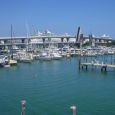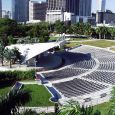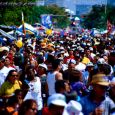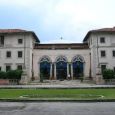Miami
Advertisement
By Air
Miami International Airport is located just west of the city in an unincorporated suburban area. It is an important hub for traffic between North America and Latin America, and one of the largest airports in the world. As a result, Spanish is just as likely to be understood as English. The international traffic makes MIA a large and congested place. Be sure to allow extra time when departing MIA, particularly if flying internationally, as you may face an hour-long line just to check your bags. Curbside check-in is an excellent idea.
By Train
Amtrak's Silver Service operates two trains daily to Miami from New York City, Washington, D.C. and other cities along the Eastern Seaboard. The ride from New York is about 24 hours but is often subject to delays, as Amtrak uses poorer-quality freight lines south of Washington and must cope with slow freight trains along the way.
There are frequent (at least 1 per hour) Tri-Rail trains every day to Miami from West Palm Beach, Boca Raton and Fort Lauderdale on weekdays. However, on the weekends, the trains come every 2 hours. The weekday fare varies by distance but the weekend fare is $4 between any two stations on the line.
By Bus
There is a bus station in Overtown at NW 1st Avenue at NW 10th Street. It is 3 blocks away from the Historic Overtown/Lyric Theater MetroRail station. Beware that this isn't the safest area to hang around in.
By Metromover
Downtown Miami is served by a free elevated people mover system known as Metromover, which connects to Metrorail at two stations at Government Center in the central business district and at Brickell Station in Brickell. Metromover is free of charge and is the most efficient way to move around Downtown Miami. It is a great way to take a rest when walking around downtown, and a great time to take pictures of the skyscrapers and growing Miami skyline from above.
Currently a funding boost has set forth an expansion for the Metrorail system including a connection to Miami International Airport to be operating by 2010. Further expansion to the north toward Dolphin Stadium (the home of the NFL's Miami Dolphins) is expected to be operating by 2012. A light rail line to Miami Beach is also under development, as well as the Miami Streetcar connecting Downtown Miami to the Media and Entertainment District as well as Midtown Miami.
Bayfront Park
Bayfront Park, on the east side of Biscayne Boulevard, was redesigned in the 1980s. An attractive feature is the electronically controlled Pepper Fountain. Other highlights include an amphitheatre used for musical performances of all kinds, a tower for laser illuminations, and three important monuments: the Torch of Friendship, symbolising Miami's relationships with the countries of Central and South America; the World War II Memorial; and the Challenger Memorial, commemorating the crew of the Challenger spacecraft which exploded in 1986.
Bayside Marketplace
Bayside Marketplace is a large mall with more than 150 specialty and tourist shops, numerous cafes and restaurants and daily live entertainment. Tour boats leave from here, which visit locations around Biscayne Bay. As well, there is a water taxi service to Miami Beach and downtown hotels located here.
Calle Ocho
From Bayfront Park (Brickell Avenue) 8th Street runs west over the Miami River. Outside the city centre with its skyscrapers it is known as Calle Ocho, and continues into the Tamiami Trail, which runs through the Everglades. The district on the west side of downtown Miami through which it runs is known as Little Havana because of the many Latinos, particularly Cuban exiles, who live here: hence also the Spanish name Calle Ocho ("Street 8"). Between SW 12th Avenue and SW 27th Avenue is an area of shops, small markets and cheerful cafes and restaurants with a friendly and relaxed atmosphere. The everyday language of Little Havana is Spanish. Planning controls seek to maintain the "Cuban" character of 8th Street.
Vizcaya Museum and Gardens
Vizcaya Museum and Gardens was the former home of early 20th century industrialist, James Deering. Built in 1916, the mansion features 34 rooms arranged around a central courtyard. This 28-acre estate and Italian Renaissance-style villa is filled with European furniture and decorative arts from the 15th to 19th century. It took more than 1,100 workers and craftsmen to complete the Vizcaya project, many of whom were brought over from Europe to ensure authenticity in design.
The gardens contain a number of Italian and French fountains, pools and sculptures. A breakwater at the base of the steps leading into Biscayne Bay is carved into the form of female figures. The name "Vizcaya" is a Basque word meaning "an elevated place The estate has hosted a number of world leaders and important historical events including the meeting between Pope John Paul II and the former president Reagan in 1987 as well as Queen Elizabeth II during her 1991 tour of America.
Information not available





